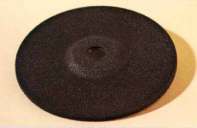Nittobo Group strives to contribute to the realization of an enriched society,
serves as a valued corporate group in society, and commits to the creation of comfortable life.
Cloth for whetstones and aluminum filtration
Glass cloth is used to enhance the strength of whetstones and for filters, by utilizing the toughness and heat resistance of glass fiber.
Cloth for whetstones
With the large diameter of its fibers and its coarse fabric structure, glass cloth is used as reinforcement for resinoid whetstones (offset, cut-off, and other whetstones), which are widely used in such industries as iron and steel, shipbuilding, and construction.
Glass cloth is indispensable to safe whetstones as it enhances the rotational fracture strength and the impact resistance of whetstones.
Various types of cloth can be chosen according to the type, size, thickness, and other attributes of whetstones.

- What are resinoid whetstones?
- 1. Liquid phenol resin is impregnated into glass cloth to form prepreg.
- 2. Glass cloth/phenol prepreg is die cut into the designated discoidal dimensions so that the material is used for molding.
- 3. Together with abrasive grain, the molding material in the discoidal dimensions is molded into the shape of a whetstone.
- 4. This wheel is hardened in a furnace to produce a resinoid whetstone.
Cloth for aluminum filtration
Glass cloth is used for filters to remove impurities in melted aluminum employing the heat resistance of glass fiber.
From among various types of cloth with different levels of weaving density and coarseness of texture, the most suitable one can be chosen according to the size of impurities to be removed.
WA plain weave cloth and WG cloth, both of which are sealed, and mock leno weave cloth, whose raw fabric can be used as is, are available for aluminum filtration.
Specifications (standard)
| Product code | Manner of weaving |
Thickness mm |
Width mm |
Weight g/m² |
Density (/25mm) |
Tensile strength (N/25mm) |
Length m |
||
|---|---|---|---|---|---|---|---|---|---|
| Warp | Weft | Warp | Weft | ||||||
| WG 240 115 |
Plain | 0.29 | 1150 | 235 | 11 | 11 | >870 | >870 | 120 |
| WA 350 100 |
Plain | 0.37 | 1000 | 341 | 20 | 20 | >1310 | >1310 | 120 |
| WA 370 100 |
Plain | 0.34 | 1000 | 319 | 14 | 14 | >1200 | >1200 | 100 |
| WA 580 100 |
Mock leno | 0.42 | 1000 | 454 | 31 | 24 | >1830 | >1550 | 60 |
- * These figures are standard ones for untreated cloth. Cloth thickness is slightly increased if the cloth is sealed.
- Business introduction
- Glass Fiber
- What is glass fiber?
- Special materials
- Composite materials
- Yarn
- High-performance glass cloth
- Industrial materials
Interior furnishings market
Market for exterior furnishings
Construction market
Lifestyle, sports, and leisure markets
Media market
Automobile and aircraft markets
Heat resistance and heat insulation markets
Civil engineering market
Market for industrial base materials
- Medical
- Textile
